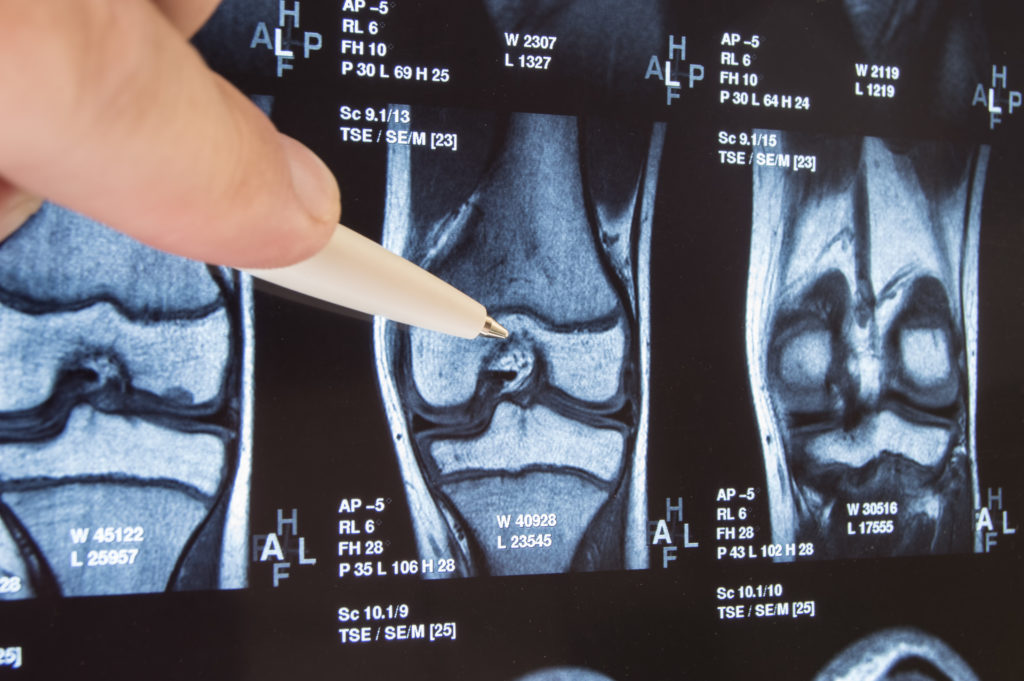THIS POST IS PART OF THE ULTIMATE GUIDE TO TOTAL KNEE REPLACEMENT
Rheumatoid arthritis and osteoarthritis are both conditions that affect the cartilage between your joints. However, one is an autoimmune disease, and one is a degenerative condition. Both can be corrected by non-operative or surgical treatment.
OrthoIndy total joint replacement surgeon, Dr. Edward Hellman discusses the differences and similarities between osteoarthritis and rheumatoid arthritis.
What is rheumatoid arthritis?
“Rheumatoid arthritis is primarily an autoimmune disease,” Dr. Hellman said. “The body’s immune system attacks the joints resulting in pain and swelling coming from the lining of the joint. Ultimately, this can result in the breakdown of the joint surface with permanent damage to the joint.”
A rheumatologist provides a rheumatoid arthritis diagnosis for the condition and will begin conservative treatment. If conservative treatment is ineffective and your condition worsens, surgery may be considered with an orthopedic specialist.
According to Healthline, over 1.3 million Americans have rheumatoid arthritis. Women are almost two to three times more likely to contract this condition, although the exact reason for this is unknown.
What is osteoarthritis?
Osteoarthritis is a degenerative disease that affects the thick, shiny white cushion between your bones, called cartilage.
“Osteoarthritis is damage to the joint caused by wear and tear over time,” Dr. Hellman said. “It can be accelerated by deformity like bowlegs or knock knees or damage to the joint caused by injury.”
The cartilage breaks down until there is no space between the two bones and they rub together. This causes stiffness, pain and a minimal range of motion. It affects your knees, feet, hips, neck and lower back. It can also affect other joints if there was a previous injury.
Difference between osteoarthritis and rheumatoid arthritis
The most obvious difference between the two forms of arthritis is the cause behind each condition. Osteoarthritis is a degenerative disease, which means the cartilage between your bones in your joints wears down from activity over time. Osteoarthritis is usually present in joints you have used often in your life and does not need to be symmetrical to the other side of your body.
Osteoarthritis can be diagnosed by an orthopedic specialist. Depending on its severity, you may need a total joint replacement, which replaces the cartilage cushioning your joint.
Rheumatoid arthritis is caused by your immune system attacking the synovium. Over time, this will break down the cartilage within your joint, closing the gap cushioning your bones.
Rheumatoid arthritis is diagnosed by a rheumatologist and in mild cases, can usually be treated with conservative treatment. However, if your condition worsens, you may need to consult a total joint replacement doctor for surgery options.
According to Dr. Hellman, the early treatment of the conditions varies significantly. While rheumatoid arthritis can be treated with strong medications sometimes, osteoarthritis cannot.
“When rheumatoid arthritis is diagnosed before it has caused significant damage to joint surface cartilage it can be treated by rheumatologists with disease modifying antirheumatic drugs (DMARDs) that moderate the immune response,” Dr. Hellman said. “This reduces the inflammation and can prolong the life of the joint.”
Rheumatoid arthritis begins on one side of the body and usually affects the other side of your body as well, unlike osteoarthritis.
Arthritis starting in your smaller joints first like your fingers and toes is one of the signs of rheumatoid arthritis. It will eventually spread to your hand, foot, knee or hip if it’s not treated. This happens because if your immune system is not put in place, it will keep attacking your healthy synovium.
This is different from osteoarthritis. Osteoarthritis will continue to wear on whatever joint or joints have been affected by degeneration until the joint is replaced.

What are the similarities between osteoarthritis and rheumatoid arthritis?
Rheumatoid arthritis and osteoarthritis have several similarities. By appearance, the conditions’ symptoms are very similar.
Osteoarthritis and rheumatoid arthritis symptoms include:
- Joint stiffness
- Limited range of motion
- Pain worsening with activity
- Joint swelling
- Inflammation
- Swelling
“Both osteoarthritis and rheumatoid arthritis can result in permanent damage to joint surfaces causing pain and disability,” Dr. Hellman said. “Once permanent joint surface damage is present joint replacement can be done for either rheumatoid arthritis or osteoarthritis.
Initial treatment may vary, since rheumatoid arthritis is an autoimmune disease and osteoarthritis is a degenerative disease. If either arthritis becomes worse and needs surgical attention, they are both usually treated with a partial or total joint replacement.
LEARN MORE ABOUT TOTAL JOINT REPLACEMENT
What is the treatment for rheumatoid arthritis and osteoarthritis?
A joint replacement is always the last option that any orthopedic specialist will suggest. However, if nonsurgical treatment fails, total joint replacement surgery may be considered as the best treatment for osteoarthritis and rheumatoid arthritis.
Total joint replacement surgery will replace the cartilage at the ends of the bones where the bones meet. This will help them glide smoothly while you’re using them. This surgery will also reduce swelling and inflammation, since your bones have a cushion and will no longer rub together.
“When we ‘replace’ the knee joint, we actually resurface the ends of the bone with metal that is about the same thickness as the original and then the piece of plastic goes in between the pieces of metal and functions as the new bearing surface,” said Dr. Frank Kolisek, OrthoIndy total joint replacement surgeon.
If you get a total joint replacement, your immune system will also have no cells left to attack, since your joint will now be artificial.
About 95 percent of hip replacements last 15 to 20 years and about 85 percent of knee replacements last 20 years.- Where is this data from? Whether you’re suffering from rheumatoid arthritis or osteoarthritis, invest in your future to get you back to your normal.
To schedule an appointment with Dr. Hellman, please call 317.802.2844 or learn more about OrthoIndy Total Joint Replacement.
Schedule an appointment
Your well-being is important to us. Click the button below or call us to schedule an appointment with one of our orthopedic specialists. If your injury or condition is recent, you can walk right into one of our OrthoIndy Urgent Care locations for immediate care. For rehabilitation and physical therapy, no referral is needed to see one of our physical therapists.





